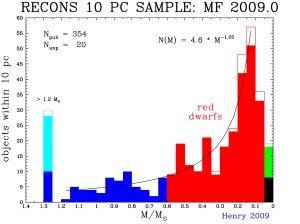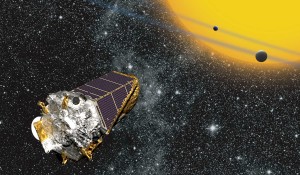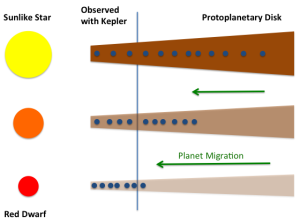Exoplanets around Red Dwarf Stars by Gijs Mulders
Since the discovery in 1995 of the first exoplanet over two-thousand exoplanets have been discovered. Most exoplanets, such as those discovered by the Kepler spacecraft, orbit stars similar in mass to the sun. Directly imaged planets, such as those discussed by Kevin Wagner in a previous blog post, are mainly discovered around stars more massive than the sun (A or F stars). However, most stars in the galaxy, around 75%, are lower mass stars called red dwarfs, or M stars (See Figure 1).

Stars in the solar neighborhood. The vast majority of stars are low-mass red dwarfs. Sun-like stars (blue) are less common. An estimated 75% of stars in the galaxy are red dwarfs.
These stars burn slowly through what little fuel they have. These stars are faint and red, like the smoldering ashes leftover then the flames of a campfire have died out. They are so faint that they are invisible to the naked eye, and famous red dwarfs like Kapteyn’s star can only be seen with binoculars. The closest star to the sun, proxima centauri, a companion of alpha centauri, is also a red dwarf.
It seems crazy to look for planets around these faint red dwarfs, yet they have a few advantages. Because the stars are much smaller in size than the sun, a transiting planet covers a larger fraction of its surface, and is therefore easier to detect. When the earth moves in front of the sun it blocks about 0.01% of its light. M stars can be up to 10 times smaller, which means a transiting earth-like planet can block up to 1% of the stellar light: a signal that is much easier to detect. Because the stars are also faint, planets can be located close to the star and still have a temperature that supports liquid water on the surface. Cool, small planets are therefore easier to find around red dwarfs, and to date, most of the planets discovered in the “habitable zone” of a star have been found around stars much lower in mass than the sun.
I started working on planets around low-mass stars back in 2013. I had just finished my PhD in Amsterdam working on protoplanetary disks, the birth-sites of planets, and I was ready for a new endeavor. I looked across the pond, and was hired as a postdoc in Arizona to work on formation of planets around lower mass stars. The chair of my PhD-thesis committee joked about Arizona: “The good news about Arizona it that it’s only 45 degrees (110 F) in the shade. The bad news is that there is no shade.” Excited by the prospect of working on exoplanets, I was ready to abandon my Dutch lifestyle of cycling around and getting rained on frequently. As it turns out, I still cycle around in Tucson and what being rained on lacks in frequency, it makes up for in intensity. The Sonoran desert and its monsoon storms are truly impressive (Figure 2).

The Kepler spacecraft has monitored the brightness of over a 100.000 stars for four years. The tiny dip in brightness when a planet passes in front of one of these stars is called a transit. Kepler has discovered more than a thousand planets this way, and many more thousands of planet candidates awaiting verification. Image Credit: NASA Ames.
We (myself and EOS members Ilaria Pascucci, Fred Ciesla, and Daniel Apai) were planning to run simulations on planet formation around low-mass stars. So we thought it would be a good idea to look at the Kepler planets. Kepler (Figure 3) observed over 100.000, mainly sun-like stars, but also a few thousand red dwarfs. A paper showing what protoplanetary disks masses were needed to form the Kepler planets around sun-like stars just appeared online. It made sense to investigate what disk masses where needed to form the planets around red dwarfs. So I started a small research project investigating what the Kepler planet population looked like around stars of different masses.

Cartoon showing how efficient planet migration around red dwarfs lead to the more observed planets than around sunlike stars, even though the disk is lower in mass and forms fewer planets in total. The blue line indicates the region where Kepler can detect planets.
As often in academia, a research project is like an exploration voyage. You set out with a goal in mind, but often discover things you never expected to find. We know that protoplanetary disks around red dwarfs are lower in mass, so we expected them to form fewer or smaller planets. The opposite turned out to be the case: red dwarfs have more planets than sun-like stars! How can a lower mass disk form more planets? A likely explanation is that planets migrate during formation, and that red dwarfs are extremely efficient at moving their planets close to the star where Kepler can observe them (Figure 4). Why they do this is still not clear, and I’m looking forward to investigating this problem further with EOS in the future.

